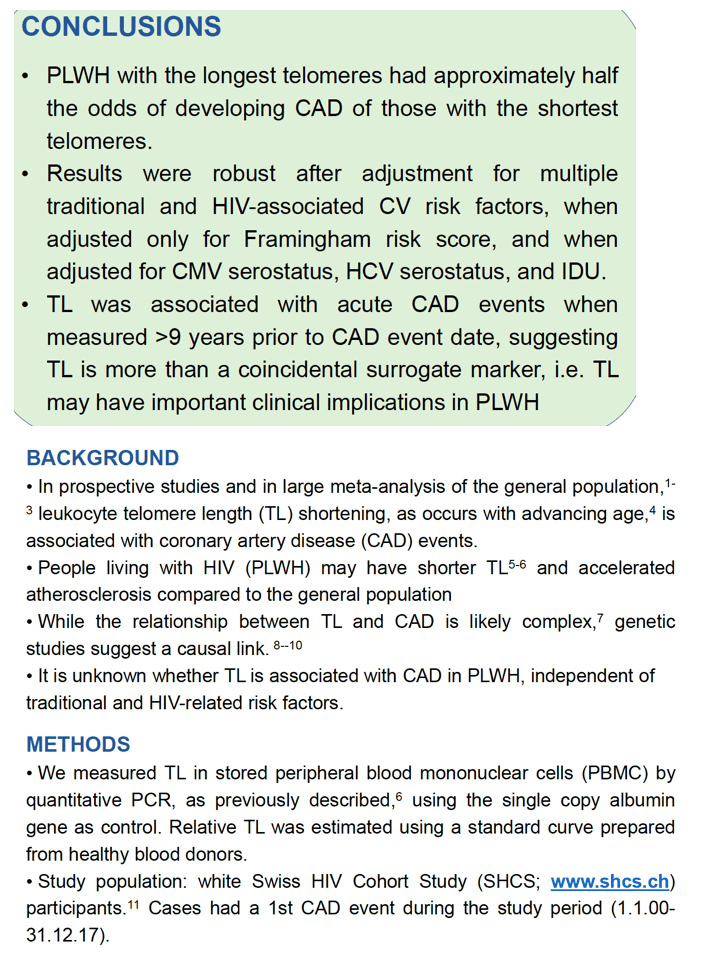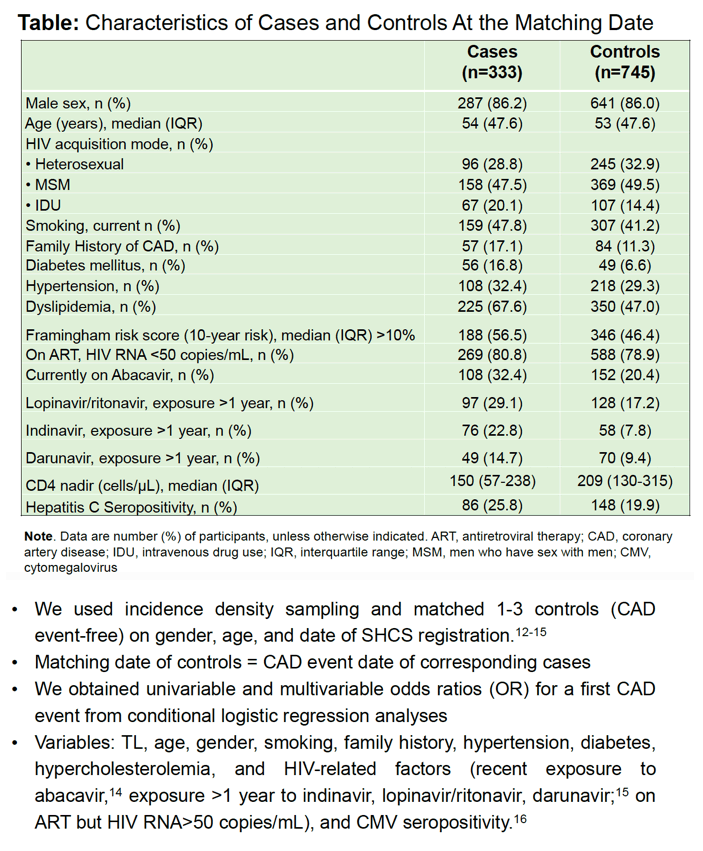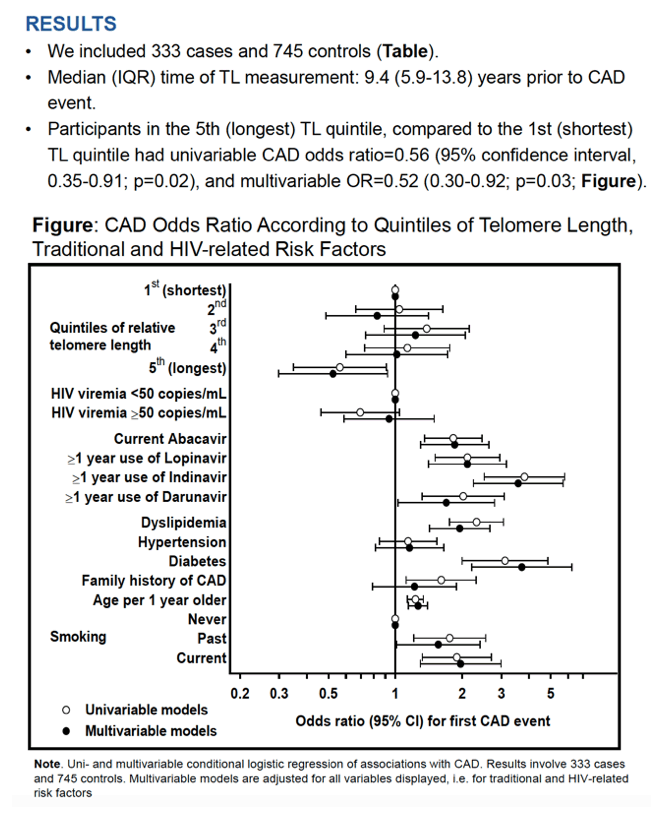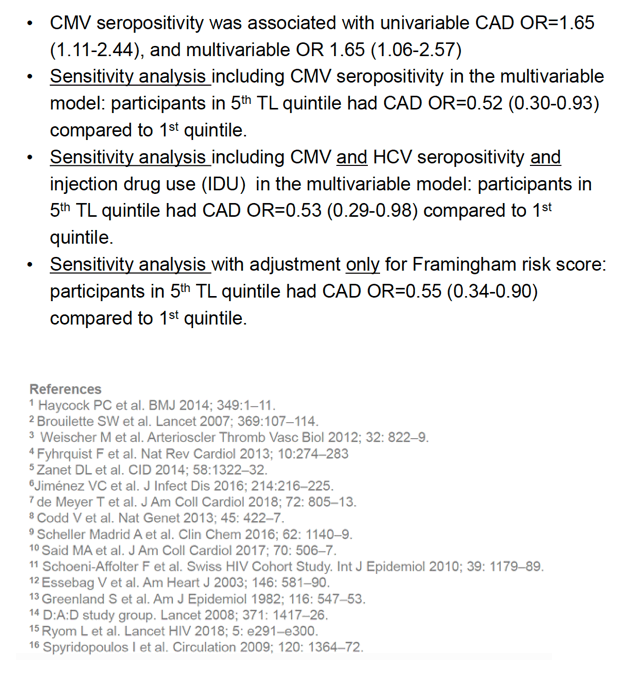| |
Telomere Length, Traditional Risk Factors, HIV-related Factors and Coronary Artery Disease Events in Swiss Persons Living with HIV
|
| |
| |
Download the PDF
CROI 2020 Isabella C. Schoepf1a, Tanja Engel1a, Marieke Raffenberg1a, Neeltje Kootstra2, Peter Reiss3, Christian Thorball4, Jacques Fellay4,5, Roger Kouyos6, Huldrych Günthard6, Bruno Ledergerber6,
Philip E. Tarr1, and the Swiss HIV Cohort
1Medizinische Universitätsklinik, Kantonsspital Baselland, University of Basel, Bruderholz, Switzerland; 2Department of Experimental Immunology, Amsterdam University Medical Centers, University of Amsterdam, Netherlands;
3Department of Global Health and Division of Infectious Disease, Amsterdam University Medical Centers, Location AMC, University of Amsterdam, Netherlands; 4EPFL School of Life Sciences and Swiss Institute of Bioinformatics;
Lausanne, Switzerland; 5Precision Medicine Unit, CHUV, University of Lausanne, Switzerland; 6Division of Infectious Diseases, University Hospital Zurich, University of Zurich, Switzerland a=equal contribution
abstract
In the general population, leukocyte telomere length (TL) shortening, as occurs with advancing age, is associated with coronary artery disease (CAD) events. The relative contribution of TL, HIV-related and traditional risk factors to CAD has not been quantified in HIV-positive persons.
We measured TL in stored peripheral blood mononuclear cells (PBMC) as previously described (Cobos Jimenez J Infect Dis 2016) by quantitative PCR, using the single copy albumin gene as control. Relative TL was estimated using a standard curve prepared from healthy blood donors. Study participants were white Swiss HIV Cohort Study participants. Cases had a 1st CAD event during the study period (1.1.00-31.12.17). We used incidence density sampling and matched 1-3 controls (CAD event-free) on gender, age, and date of registration. We obtained univariable and multivariable odds ratios (OR) for a first CAD event from conditional logistic regression analyses, including as variables TL, age, gender, smoking, family history, hypertension, diabetes, hypercholesterolemia, and HIV-related factors (recent exposure to abacavir, exposure >1 year to indinavir, lopinavir/ritonavir, darunavir; ART discontinuation; on ART but HIV RNA>50 copies/mL).
We included 333 cases (median age at CAD event, 54 years; 14% women; 83% with HIV RNA<50) and 745 controls. Median (IQR) time of TL measurement was 9.4 (5.9-13.8) years prior to CAD event. Participants in the 5th (longest) TL quintile, compared to the 1st (shortest) TL quintile had univariable CAD odds ratio of 0.56 (95% confidence interval, 0.35-0.91; p=0.02), and a multivariable OR of 0.47 (0.26-0.86; p=0.01; Figure). In comparison, the OR for current smoking was 2.28 (1.46-3.56), hypercholesterolemia 1.84 (1.33-2.55), diabetes 3.92 (2.26-6.78), on ART/HIV RNA>50 1.80 (0.95-3.42); recent abacavir, cumulative lopinavir, indinavir, darunavir exposure 1.84 (1.28-2.64), 1.87 (1.23-2.84), 3.22 (1.99-5.21), and 1.68 (1.01-2.78), respectively.
HIV-positive persons with the longest telomeres (measured >9 years prior to CAD event) had approx. half the odds of developing CAD of those with the shortest telomeres. TL measurement may, in addition to traditional and HIV-related risk factors, provide prognostic information with respect to CAD risk.




|
|
| |
| |
|
|
|